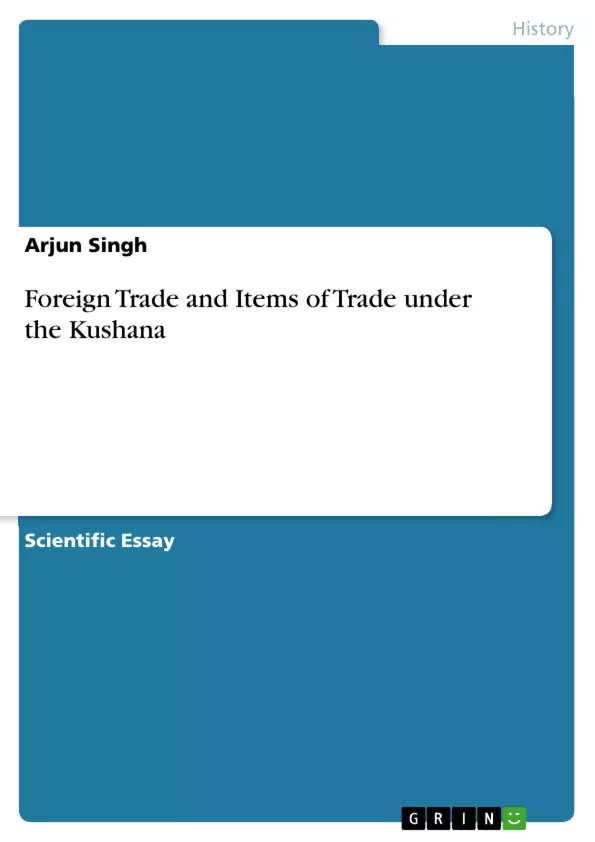Indian foreign trade with the Western world is known to have existed since the Harappan period, but it reached a high watermark under the Kushana. The Geo-political situation of the Kushana Empire makes the North-Western region of the country, the meeting points of the three civilizations i.e. China, India and West Asia. The brick trade was carried on the regions between Ganga, The Indus, The Euphrates, The Oxus and the Mediterranean, Caspian and Black-Sea, especially with Roman Empire, in the first century and second century A.D. and Kushana Empire had a great share in it. The prosperity of Kushana towns developed largely on the wealth derived from their international trade.
Inhaltsverzeichnis (Table of Contents)
- Introduction
- Trade and Commerce under the Kushana Rule
- Literary and Archaeological Sources
- Geo-Political Situation of the Kushana Empire
- Items of Trade
- Discovery of Monsoon Winds
- Inscriptions and Professions
- Foreign Trade in the Early Centuries of the Christian Era
- The “Silk Road”
- Coined Money and Trade
- Trade with the Roman Empire
- Trade with Eastern Turkistan
- Trade with China
- Sea Trade with Foreign Countries
Zielsetzung und Themenschwerpunkte (Objectives and Key Themes)
This text aims to explore the flourishing trade and commerce during the Kushana period in India. It examines the significance of the Kushana rule in fostering economic stability and the growth of trade relations with various countries, including the Roman Empire, China, and Central Asia.
- The role of the Kushana Empire in promoting trade and commerce in India
- The development of trade routes and transportation networks
- The importance of monsoon winds in facilitating maritime trade
- The significance of coin money in facilitating economic transactions
- The impact of trade relations with various countries, including the Roman Empire, China, and Central Asia
Zusammenfassung der Kapitel (Chapter Summaries)
The introduction provides an overview of the Kushana period, highlighting its significance in restoring political unity and economic stability to India. It discusses the flourishing trade and commerce during this period, facilitated by land routes and sea ports.
The text delves into the literary and archaeological sources that provide evidence for the flourishing intercourses of trade between India and other nations. It emphasizes the importance of trade routes and communication networks, particularly the North-Western route connecting Gandhara to the Middle East and China. It also details the major articles of trade, including precious stones, cotton, and silk cloth.
The text explores the significance of the discovery of monsoon winds in facilitating maritime trade. It further explores various professions during the Kushana period based on inscriptions and literary sources, such as government officers, traders, farmers, artists, and laborers.
The text examines foreign trade during the early centuries of the Christian era, drawing upon classical Greco-Roman writers. It highlights the importance of ports and towns in Western and Southern India, and emphasizes the role of the Kushana in controlling the Silk Road.
The text emphasizes the use of coined money, facilitated by the Kushana, which played a significant role in the growth of trade. It discusses the importance of the port of Tamralipti for Indo-Chinese and south-east Asian trade, and highlights the insatiable demand for oriental luxury goods in the Roman Empire.
The text details the trade relations between India and the Roman Empire, discussing the exchange of goods such as Indian minerals and precious stones for Roman gold and other commodities. It highlights the concern caused by the drain of gold from the Roman Empire to India and the measures taken by the Kushana to mitigate the impact on their currency.
The text explores the trade relationship between India and Eastern Turkistan, highlighting the expeditions of Kanishka and the importance of trade centers such as Samarkand, Kashgarh, and Khotan. It further discusses the influence of Indian culture and religion, particularly Buddhism, on Khotan.
The text examines trade between India and China, citing evidence from Chinese texts and classical sources. It discusses the trade routes connecting India and China, and highlights the role of the Kshatrapa dynasty of Kathiawar in facilitating trade.
The text explores the importance of sea trade in connecting India to the Roman world, the Chinese empire, and Southeast Asia. It highlights the major sea routes and ports, providing a detailed account of the maritime trade network and the types of goods traded.
Schlüsselwörter (Keywords)
The key topics of the text include the Kushana period in India, foreign trade, trade routes, monsoon winds, coin money, the Roman Empire, China, Central Asia, and the Silk Road. The text focuses on the impact of the Kushana rule on trade and commerce, highlighting the flourishing economic activity and the interconnections between India and other major civilizations during that period.
- Quote paper
- Dr. Arjun Singh (Author), 2014, Foreign Trade and Items of Trade under the Kushana, Munich, GRIN Verlag, https://www.hausarbeiten.de/document/275450


